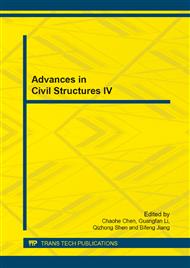p.675
p.679
p.687
p.691
p.695
p.699
p.703
p.707
p.711
Finite Element Analysis of Concrete-Filled Rectangular Tubular Frame
Abstract:
Based on the model experiment on seismic behavior of a 1-span, 2-story concrete-filled rectangular steel tubal (CFRST) frame under lateral cyclic loads, a 3-D nonlinear finite element model of concrete-filled rectangular steel tubular frame is proposed in the paper. Compared with the experimental hysteresis curve, the computational results are found to be accurate, which shows that this model proposed in the paper can be applied in structure analysis of concrete-filled rectangular tubular frames. So the model was used in the finite element analysis of concrete-filled rectangular frame with different axial load level. Compared the computational displacement envelop curves, it concludes that the ductility and bearing capacity of CFRST frames reduces with the increasing axial load level.
Info:
Periodical:
Pages:
695-698
Citation:
Online since:
July 2014
Authors:
Keywords:
Price:
Сopyright:
© 2014 Trans Tech Publications Ltd. All Rights Reserved
Share:
Citation:


